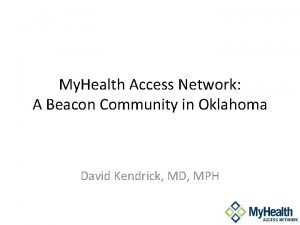A Digital Dilemma Improving EMR Documentation in WellChild

- Slides: 1

A Digital Dilemma: Improving EMR Documentation in Well-Child Visits Sabrina Silver, DO; Stephanie Reiser, DO; Kevin Sisk, DO; Rebecca Englebretson, DO; TJ Coker, MD Family Medicine Residency, University of Nebraska Medical Center, Omaha, NE 68198 and Offutt AFB Introduction Armed Forces Health Longitudinal Technology Application (AHLTA) = EMR in use at this military outpatient facility • Contains built-in workflows for documenting well-child visits • Incorporates the preventive health measures recommended by the AAP 1 Hurdles to consistent documentation identified at this military family medicine residency program: • Lack of communication with EMR at civilian birth facility requires transference of newborn patient information from hospital chart to outpatient clinic • Key birth history components must be manually entered or carried forward each clinic visit • Lack of awareness of charting standards and responsibilities among technicians and providers • Infrequent occurrence of these visits in the clinic PDSA 3, 4 Cycles Peer-reviewed 30 randomized 0 -12 month well-child visits to establish baseline Study Design: Pre/Post Training provided to half of clinic to improve clinical Quality Improvement documentation Trained entire clinic, reassigned all components to technicians Results 90, 00% 70, 00% AIM Statement: Utilize the PDSA model to increase documentation of 5 different components to >50 % in 1 year. 30, 00% Methods Three Plan, Do, Study, Act (PDSA) cycles, each followed by chart review to assess for the following components: • Growth Curve (GC) • Ages & Stages Questionnaire (ASQ) • Newborn Screening (NS) • Birth History (BH) • Handout Given (HG) Components chosen based on AAP Bright Futures Preventive Pediatric Health Care recommendations 2 Study Design: Pre/Post Quality Improvement GC ASQ NS BH HG 60, 00% 50, 00% Odds Ratio Component p-value Component OR (95% CI) p-value GC 0. 03 GC 3. 89 (1. 06 -14. 29) 0. 04 ASQ <0. 01 ASQ 5. 78 (2. 87 -11. 67) <0. 01 NS 2. 48 (1. 52 -4. 03) <0. 01 BH 1. 76 (1. 11 -2. 79) 0. 02 HG 0. 20 HG 1. 5 (0. 96 -2. 38) 0. 08 Conclusions and Future Directions 100, 00% Develop a workflow with the EMR to improve availability of newborn preventive metrics at routine visits. Chi-Squared Interpretation for GC component: chi-squared shows change between cycles was significant. Change occurred with the intervention and GC was 3. 89 times more likely to be charted correctly after the training. 80, 00% Objective Analysis 40, 00% Conclusions: • Educating technicians on how to copy forward and chart tracked components using the PDSA model can improve charting, without increasing physician workload • The gap created by non-communicating EHRs can be improved upon with an awareness of essential chart components • Clarifying documentation standards and responsibility of providers vs. technicians leads to more complete charting Further areas of study • Standardized checklists for infrequent encounter types • Delegate central clinic personnel to obtain outside records 20, 00% 10, 00% PDSA Cycle #1 Age (m) Cycle 1 Cycle 2 0 0 4 0. 5 1 6 2 4 23 4 6 13 6 9 15 9 3 4 12 7 0 Total 30 65 Cycle 3 2 2 11 16 11 11 0 53 Number of Charts by Age PDSA Cycle #2 PDSA Cycle #3 References 100, 00% 90, 00% 1. Hagan JF, Shaw JS, Duncan P, eds. 2008. Bright Futures: Guidelines for Health Supervision of Infants, Children, and Adolescents, Third Edition. Pocket Guide. Elk Grove Village, IL: American Academy of Pediatrics. 2. Langley GL, Moen R, Nolan KM, Nolan TW, Norman CL, Provost LP. The Improvement Guide: A Practical Approach to Enhancing Organizational Performance (2 nd edition). San Francisco: Jossey-Bass Publishers; 2009. 3. Speroff, Theodore, and Gerald T. Oʼconnor. "Study Designs for PDSA Quality Improvement Research. " Quality 80, 00% 70, 00% 60, 00% 50, 00% Management in Health Care 13. 1 (2004): 17 -32. 40, 00% 30, 00% Acknowledgement 20, 00% 10, 00% GC ASQ NS BH HG Final Review with Goal of 50% met The views expressed in this material are those of the authors, and do not reflect the official policy or position of the U. S. Government, the Department of Defense or the Department of the Air Force. Special thank you to Dr. Jestin Carlson, MD for his help with statistical analysis.

